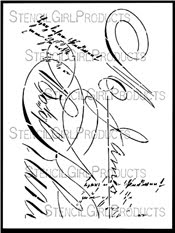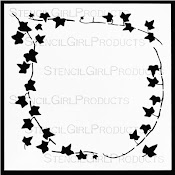Once the stencil is lined up where you want it, place a ruler where you want to cut the new stencil edge. Use the mat's guidelines to keep the ruler straight and, with a Sharpie pen, draw a cutting line. You can then lift off the stencil and cut it with scissors -- but better yet, for a perfect cut, you can leave the stencil and ruler on the cutting mat, and cut along the line with an
X-acto knife.
Likewise, you can easily customize my 9"X12" stencil
Wrought Iron Gate to make it a Repeating Pattern Stencil. Just line it up on the cutting mat and cut off the "ornament" at the top of the "gate." Below, I've used a ruler with a metal edge that will be useful in the next step, when I will use my X-acto knife to do the cut. But for now, I'm just drawing the guideline for the cut:
 |
| Above: I've placed the stencil onto the cutting mat, lining it up with the measuring grid pre-printed on the mat. Those blue lines helped me place the ruler exactly where I wanted, to draw a line between the ornate "gate top" and the rest of the stencil. This is shown better in the close-up below: |
 |
| Click on the above image to enlarge it. This will help you better see the ornate "gate top" that is to be cut off. |
 |
| The above photo shows the ruler pulled away from the line that I've drawn. The cut will be made here. |
One important thing to note is that this stencil customization gives you an edge-free design. This kind of raw-edged stencil is more fragile, but the lack of an outer border makes it easier to align prints side-by-side, for a seamless overall effect.
Stencils are tools to be personalized any way you want to achieve your unique artistic goals!




















































































